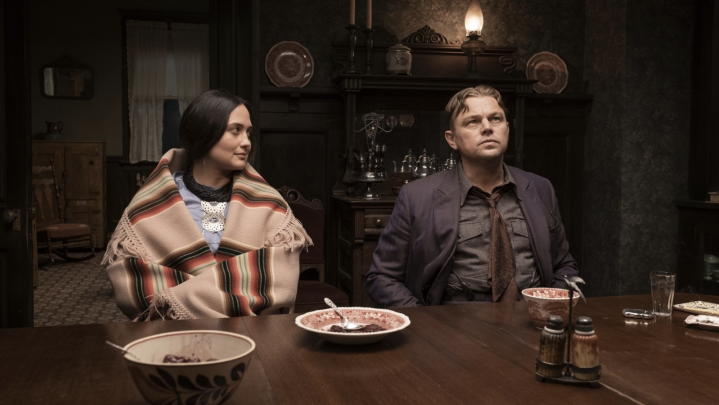
The curse of “black gold”

We’ve selected “Killers of the Flower Moon,” the 2017 book by David Grann that was just adapted for the screen by Martin Scorsese, for November.
It tells a violent story of greed, theft and murder throughout the 1920s, when many white Americans married and killed Osage men and women so they could inherit their oil rights. A series of suspicious deaths and murders in one particular Osage family prompted a federal investigation that exposed the violent conspiracy.
This isn’t a whodunit true crime story. The audience learns who the conspirators are and their motives very early on in the film. Rather, as RogerEbert.com reviewer Brian Tallerico wrote, the film’s narrative centers on evil operating in plain sight. We hope to explore more deeply what the film did and did not explore about this time in history and what has happened in the century since.
“Killers of the Flower Moon” is available for purchase from many booksellers, or you can borrow it from your local library. You can watch the feature film, starring Lily Gladstone, Leonardo DiCaprio and Robert De Niro, in theaters nationwide.
Have you already seen the film or read the book? Share your reflections and questions by replying to this email or sending us a line at extracredit@marketplace.org.
A timeline
Here’s a timeline of how the Osage came to Oklahoma, negotiated oil and gas rights and then became targets because of their wealth.
1300
By 1300, the Osage had settled in central and western areas of what is now the state of Missouri, along the Missouri and Osage rivers. Their name for themselves was Ni-U-Kon-Ska or Children of the Middle Waters.
1673
The Osage met European explorers for the first time, when a French priest visited several Osage settlements.
Early 1700s
The Osage established trade with French explorers and settlers, exchanging furs for horses.
1803
The Osage ancestral lands became part of the U.S. when the federal government bought 530 million acres of land from the French in the Louisiana Purchase.
1808
The U.S. was not interested in maintaining political or economic relationships with Indian nations. Instead, the government worked to remove all Indigenous people east of the Mississippi River. In 1808, the Osage signed the first treaty that ceded some of their lands. Several subsequent treaties forced them to cede more land and move several times, each time farther west into what was known as Permanent Indian Territory.
1865
The Osage agreed to cede their land in Kansas in exchange for payment from the U.S. government.
1872
The Osage bought almost 1.5 million acres of land in northeast Oklahoma from the Cherokee Nation.
1881
The Osage established its own constitution and declared sovereignty as the Osage Nation.
1887
Congress passed the Dawes Act, which established the process of “allotment,” dividing up Indian reservations into plots of 160 acres assigned to individual tribe members and selling the “surplus” land to non-natives. It was a massive shift from communal to private property. The Osage was one of the groups cited as exempt. However, the federal government later put pressure on them and other exempt groups to accept allotment as well.
Oct. 28, 1897
The Phoenix Oil Co., which received the first oil and gas lease on Osage land, completed its first oil-producing well with an initial yield of 20 barrels a day.
June 28, 1906
The Osage Allotment Act divided the reservation into 2,229 allotments of 657 acres each and one “headright,” a share of the revenue brought in from oil and gas production. These mineral rights were communally owned by the entire tribe. Allotment was seen as a necessary step before Oklahoma could become a state.
1907
1908
Congress transferred jurisdiction over land, persons and property of Native American “minors and incompetents” from the Interior Department to county courts in Oklahoma. Many county judges selected their friends as guardians, who often charged their Osage wards exorbitant fees or blatantly stole their money.
1916
The Osage began selling individual oil field leases to the highest bigger through public auctions underneath the so-called Million Dollar Elm tree, prompting a boom in royalties for the tribe. This dramatically increased the wealth of Osage people.
March 3, 1921
Congress passed a law that required Osage people to prove their competency with money. Those who failed were appointed white guardians. People of full Osage ancestry were more likely to be deemed incompetent than those of mixed ethnicity.
May 1921
Anna Brown, an Osage woman, was found dead in a ravine. She had been shot in the head.
Between 1921 and 1926, a series of murders, which became known as the Reign of Terror, were part of a conspiracy to steal Osage oil wealth. The murders of several members of the Kyle family and the subsequent investigation was the central focus of “Killers of the Flower Moon.”
In 1926, after the arrest of white cattle rancher William K. Hale, the killings subsided. He and his accomplices were tied to more than 20 killings. However, tribe members estimate that more than 100 Osage were killed for their headrights.
1925
To prevent similar conspiracies, Congress passed a law to prohibit non-Osages from inheriting headrights of tribe members with more than one-half Osage blood.
1930s
Oil production on Osage land peaked in the 1920s, and during the Great Depression, many wells on Osage land shut down and were very expensive to reactivate. As a result, the wealth of the tribe dramatically declined.
There’s a lot happening in the world. Through it all, Marketplace is here for you.
You rely on Marketplace to break down the world’s events and tell you how it affects you in a fact-based, approachable way. We rely on your financial support to keep making that possible.
Your donation today powers the independent journalism that you rely on. For just $5/month, you can help sustain Marketplace so we can keep reporting on the things that matter to you.


















